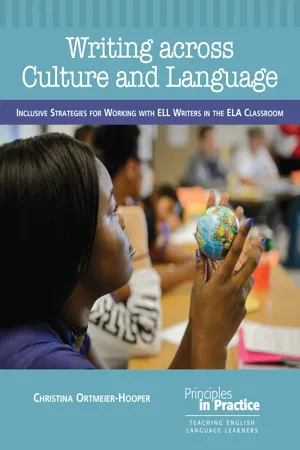
Writing across Culture and Language
Inclusive Strategies for Working with ELL Writers in the ELA Classroom
- 155 pages
- English
- ePUB (mobile friendly)
- Available on iOS & Android
Writing across Culture and Language
Inclusive Strategies for Working with ELL Writers in the ELA Classroom
About This Book
Imagine being asked to write an essay in a language you don't know well or at all, to have to express yourself—your knowledge and analysis—grammatically and clearly in, say, three to five pages. How is your Spanish, your Urdu, your Hmong?
This is what teachers ask their ELL and multilingual students to do every day in middle and high school, especially in English classes, leading to expectations both too great and too small. Teachers often resort to worksheets and grammar drills that don't produce good writing or allow these students to tap in to their first language assets and strengths. Writing well is a primary door-opener to success in secondary school, college, and the workplace; it's also the most difficult language skill to master. Add writing in a second language to the mix, and the task difficulty is magnified.
In Writing across Culture and Language, Christina Ortmeier-Hooper challenges deficit models of ELL and multilingual writers and offers techniques to help teachers identify their students' strengths and develop inclusive research-based writing practices that are helpful to all students. Her approach, aligned with specific writing instruction recommendations outlined in the NCTE Position Paper on the Role of English Teachers in Educating English Language Learners (ELLs), connects theory to classroom application, with a focus on writing instruction, response, and assessment for ELL and multilingual students. Through rich examples of these writers and their writing practices, along with "best practices" input from classroom teachers, this book provides accessible explanations of second language writing theory and pedagogy in teacher-friendly language, concrete suggestions for the classroom, guiding questions to support discussion, and an annotated list of resources.
Frequently asked questions
Information
Table of contents
- COVER
- TITLE PAGE
- COPYRIGHT
- CONTENTS
- Acknowledgments
- NOTE Position Paper on the Role of English Teachers in Educating English Language Learners (ELLs)
- Statement of Terminology and Glossary
- Chapter 1.......................... How Do ELL Students Write across Language and Culture?
- Chapter 2.......................... A Changing World: How Globalization Helps Us See the Strengths of ELL Writers in New Ways
- Chapter 3.......................... Inclusive Writing Assignments: (Re)Thinking Assignment Design
- Chapter 4.......................... Teaching Writing Explicitly: Methods for Writing Instruction in Mixed Classrooms
- Chapter 5.......................... Responding to ELL Writers and Their Texts
- Chapter 6.......................... Appropriate and Equitable: Thoughts on Evaluation and Grading
- Chapter 7.......................... Creating a School Culture That Supports Multilingual Writers
- Notes
- Annotated Bibliography
- References
- Index
- Author